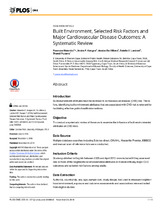Built environment, selected risk factors and major cardiovascular disease outcomes: a systematic review
Date
2016Author
Malambo, Pasmore
Kengne, Andre P.
De Villiers, Anniza
Lambert, Estelle V.
Puoane, Thandi
Metadata
Show full item recordAbstract
INTRODUCTION
Built environment attributes have been linked to cardiovascular disease (CVD) risk. Therefore,
identifying built environment attributes that are associated with CVD risk is relevant for
facilitating effective public health interventions.
OBJECTIVE
To conduct a systematic review of literature to examine the influence of built environmental
attributes on CVD risks.
DATA SOURCE
Multiple database searches including Science direct, CINAHL, Masterfile Premier, EBSCO
and manual scan of reference lists were conducted.
INCLUSION CRITERIA
Studies published in English between 2005 and April 2015 were included if they assessed
one or more of the neighborhood environmental attributes in relation with any major CVD
outcomes and selected risk factors among adults.
DATA EXTRACTION
Author(s), country/city, sex, age, sample size, study design, tool used to measure neighborhood
environment, exposure and outcome assessments and associations were extracted
from eligible studies.
RESULTS
Eighteen studies met the inclusion criteria. Most studies used both cross-sectional design and
Geographic Information System (GIS) to assess the neighborhood environmental attributes.
Neighborhood environmental attributes were significantly associated with CVD risk and CVD
outcomes in the expected direction. Residential density, safety from traffic, recreation facilities,
street connectivity and high walkable environment were associated with physical activity. High
walkable environment, fast food restaurants, supermarket/grocery stores were associated with
blood pressure, body mass index, diabetes mellitus and metabolic syndrome. High density traffic,
road proximity and fast food restaurants were associated with CVDs outcomes.
CONCLUSION
This study confirms the relationship between neighborhood environment attributes and
CVDs and risk factors. Prevention programs should account for neighborhood environmental
attributes in the communities where people live.

